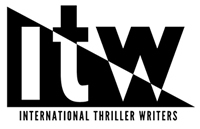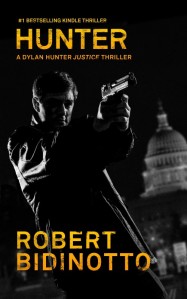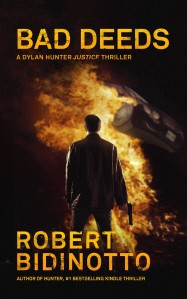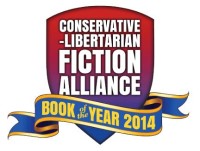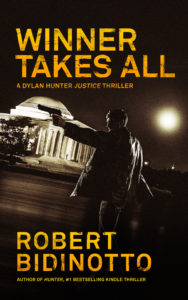Ever since my debut thriller HUNTER took off, fellow writers have asked me if, when writing, I am an “Outliner” or a “Seat Of The Pants” writer. These labels describe two extremes on a spectrum of methods that fiction authors employ to craft their books.
At one extreme, the “Outliner” is the author who plans his book in meticulous detail before he starts to write. He wants to know in advance what will happen in each anticipated chapter, sometimes in each scene. Often, he’ll write an extended synopsis or summary of the book, typically 20-50 pages of exposition describing the major characters, their conflicts, and all the significant events. (In the film industry, such a summary is referred to as a “treatment.”) Sometimes, he will write multiple drafts of his outline, in order to work out all the plot twists and possible logical holes in advance, before starting the actual writing.
When everything is finally figured out, these authors can usually write their first draft rapidly, confident that the result will be in near-final shape and in need of little revision, or that they’ll have to delete a lot of material because they discover a serious problem only after writing a draft. On the downside, such well-crafted stories might be stronger on plot than on characterization: If he isn’t careful, the outliner’s characters may become little more than stage props for the devious goings-on. Well-known outliners include historical novelist Ken Follett, mystery writer Robert Crais, and the late thriller master Robert Ludlum (whose outlines would sometimes go longer than 100 pages).
At the other end of the methodological spectrum are “seat-of-the-pants” authors (abbreviated SOTP). These authors write without planning much, if anything, in advance: The story develops organically. Some SOTP authors have an idea of the beginning and end of the tale, and maybe a few ideas along the way. Others start with less than that. Usually the SOTP writer begins with some nugget of an idea–a scene, character, concept, theme–and just dives in and starts to write, seeing where the notion takes him. Thriller author Lee Child refers to it as “the thing”–the anchoring idea or image that serves as the seed of the story. The author then writes rapidly, going wherever inspiration takes him, without editing along the way or self-censorship of any kind. The writer is as surprised by the story’s unfolding events and the words and actions of his characters as is the reader.
For the SOTP author, much of the creative pleasure lies in that exciting first-draft rollercoaster ride. However, that draft is often messy, burdened with lots of extraneous material and characters, lapses of plot logic, and other unnecessary or poorly conceived elements. Then comes the chore of heavy rewrites, editing, and revision. Famous SOTP writers include Lee Child, Stephen King, and the late thriller master Vince Flynn.
Between these two extremes lie all kinds of hybrid approaches. In his excellent how-to book Writing Fiction for Dummies, Randy Ingermanson describes the preceding two common approaches, plus a couple of others:
There is “Editing As You Go.” Horror master Dean Koontz is this kind of novelist. The author writes a scene, without advance planning–then before going on, he or she pauses to edit and polish it. The peril of this approach is that it still relies on constant SOTP inspirations, which means that the writer may waste a lot of time polishing scenes and chapters that ultimately must be discarded.
A fourth writing approach described by Ingermanson is “Plan A Little, Write A Little”–a hybrid of SOTP and outlining. The writer begins with enough advance planning to get the big picture: the plot structure, backstories for major characters, perhaps a synopsis and a list of chapters and/or scenes. But the plan doesn’t get down to the nitty-gritty details in each scene. Ingermanson himself is one such writer, and he’s developed his own approach, called the “Snowflake method,” which has become quite popular among authors. (It is described in detail in his book.)
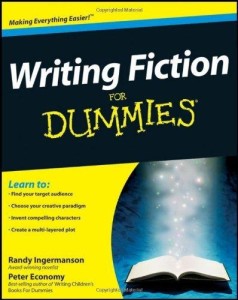 These four common methods of writing fiction don’t exhaust all the possibilities. And it’s important for any aspiring writer to know that there is no single “right way” or “wrong way” to write fiction. Fiction-writing is an art, not a science. A writer should learn how various tools of language produce certain effects on a reader, just as a painter learns how to mix pigments and use certain tools, brushes, surfaces, strokes, compositional principles, etc., to create certain effects on the viewer. But there is no “one way” to write a story. We all have different psychologies, and the choice of which approach or method to follow ought to be a natural, comfortable fit with your own psychological makeup.
These four common methods of writing fiction don’t exhaust all the possibilities. And it’s important for any aspiring writer to know that there is no single “right way” or “wrong way” to write fiction. Fiction-writing is an art, not a science. A writer should learn how various tools of language produce certain effects on a reader, just as a painter learns how to mix pigments and use certain tools, brushes, surfaces, strokes, compositional principles, etc., to create certain effects on the viewer. But there is no “one way” to write a story. We all have different psychologies, and the choice of which approach or method to follow ought to be a natural, comfortable fit with your own psychological makeup.
I lie somewhere on the spectrum between an “outliner” and a “Snowflaker.” In both HUNTER and its forthcoming sequel, BAD DEEDS, I have first done months of intensive planning and extensive outlining of chapters and scenes, although I don’t write out a long synopsis of the entire story. I adopted the “plan-and-outline first” approach because in my kind of thematically driven stories–where an idea with important philosophical, psychological, cultural, and/or political implications lies at the heart of each tale–I need to stage-manage myriad factors so complicated that they threaten constantly to spin off into complete chaos unless I keep a tight rein.
But that doesn’t mean that my creativity feels constrained while I’m actually doing the writing. I experience “organic” freedom during the scene-writing itself, when my characters assert themselves in unexpected ways, their dialogue becomes unplanned banter, and descriptions offer boundless creative possibilities. In fact, once I’ve understood my characters’ motives and goals and know what they need to do next, I often just plunk them down in a scene, buckle in, and let them take over. It’s like being a secretary off in a hidden corner of the office, taking dictation and notes. You never know exactly what these unusual folks are going to say or do next.
Take the early scene in HUNTER that introduces “Wonk.” I had a general image of the guy; I knew what the purpose of the scene had to be and what information had to be conveyed to the reader. But I had no idea about his precise manner of speech and very little about his personal style. That all just poured out during the writing. It was great fun, because like the reader, I was meeting the guy for the first time, too, and I thought he was a riot.
So, it’s not as if advance planning tediously cramps my actual writing. I find that each scene is like driving out to do errands: You know where you have to stop and what you have to buy; but you never know the exact routes you’ll take, who you’ll run into, or what impulse purchases you’ll make along the way.
My method is not for everyone because, again, there is no single “right way” to write fiction (or nonfiction). A lot of it has to do with cognitive habits and creative styles, which vary from person to person. That’s why it is a bad idea to feel that you must accept anyone’s how-to prescriptions.
That said, I’ve read lots of books about writing fiction, and I’ve learned from them all. I’ve picked and cobbled together from them an indescribable “method” that works for me, and probably no other person on the planet. I suggest that you do the same.
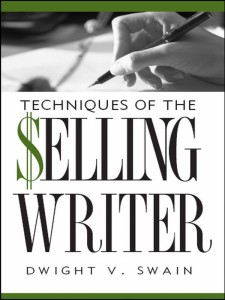 Which leads me to my personal recommendations of some “how-to” books about writing fiction. Let me first say that certain hugely popular books, like Stephen King’s On Writing and Dwight Swain’s Techniques of the Selling Writer, aren’t on the following list–the first because (for whatever reason) King’s half-memoir/half-guide just didn’t speak to me, the second only because I haven’t gotten very far into it yet (so I may come back here to rave about it when I finish it). But, of the many I have read, here are the ones I’ve found most helpful:
Which leads me to my personal recommendations of some “how-to” books about writing fiction. Let me first say that certain hugely popular books, like Stephen King’s On Writing and Dwight Swain’s Techniques of the Selling Writer, aren’t on the following list–the first because (for whatever reason) King’s half-memoir/half-guide just didn’t speak to me, the second only because I haven’t gotten very far into it yet (so I may come back here to rave about it when I finish it). But, of the many I have read, here are the ones I’ve found most helpful:
I love Writing Fiction for Dummies by Randy Ingermanson and Peter Economy not just for its unrivaled comprehensiveness, but because it offers methodological suggestions for four common types of writers: “Seat Of The Pants,” “Edit As You Go,” “Outliners,” and “Snowflakers” (those who follow Ingermanson’s own “plan a little/write a little” method). It’s my favorite, and by any measure one of the best how-to writing books available for aspiring authors who seek solid handrails to guide them forward.
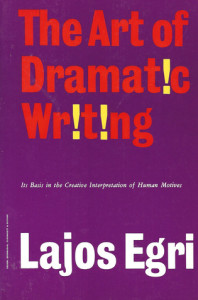 A true classic in the how-to-write-fiction category is Lajos Egri’s The Art of Dramatic Writing. While emphasizing play-writing, the book’s lessons are easily transportable into writing novels or any kind of fiction. Egri’s unique contribution and value lies in showing how to write fiction that is driven or integrated by some idea or abstract theme–in other words, the kinds of books that I like to read and write. He shows how to develop characters built around such a theme, how to put them into conflict, and how to structure that conflict into a suspenseful story whose climax “proves” the theme. (You can safely ignore his extraneous philosophical digressions into Hegelian dialectics as the source of building dramatic conflict.) This book is an invaluable guide for anyone aspiring to write serious fiction–stories with profound points to make. I highly recommend it, and at just $2.99 on Kindle, it’s an absolute steal.
A true classic in the how-to-write-fiction category is Lajos Egri’s The Art of Dramatic Writing. While emphasizing play-writing, the book’s lessons are easily transportable into writing novels or any kind of fiction. Egri’s unique contribution and value lies in showing how to write fiction that is driven or integrated by some idea or abstract theme–in other words, the kinds of books that I like to read and write. He shows how to develop characters built around such a theme, how to put them into conflict, and how to structure that conflict into a suspenseful story whose climax “proves” the theme. (You can safely ignore his extraneous philosophical digressions into Hegelian dialectics as the source of building dramatic conflict.) This book is an invaluable guide for anyone aspiring to write serious fiction–stories with profound points to make. I highly recommend it, and at just $2.99 on Kindle, it’s an absolute steal.
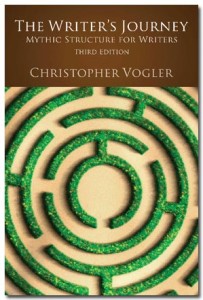 The Writer’s Journey by Christopher Vogler offers a unique approach to writing fiction. Vogler is a successful Hollywood “script doctor” who dissects what’s wrong with screenplays–then restructures and repairs them according to the “mythic archetypes” and “hero’s journey” structure described by mythologist Joseph Campbell in his classic work The Hero With a Thousand Faces. Vogler’s adaptation of Campbell’s work to fiction-writing is utterly fascinating and infinitely fertile. I strongly endorse Vogler’s justly popular writer’s guide.
The Writer’s Journey by Christopher Vogler offers a unique approach to writing fiction. Vogler is a successful Hollywood “script doctor” who dissects what’s wrong with screenplays–then restructures and repairs them according to the “mythic archetypes” and “hero’s journey” structure described by mythologist Joseph Campbell in his classic work The Hero With a Thousand Faces. Vogler’s adaptation of Campbell’s work to fiction-writing is utterly fascinating and infinitely fertile. I strongly endorse Vogler’s justly popular writer’s guide.
Another valuable how-to book on the craft of writing, and a recent discovery of mine, is Plot & Structure by James Scott Bell. One of the great challenges faced by most fiction writers is how to 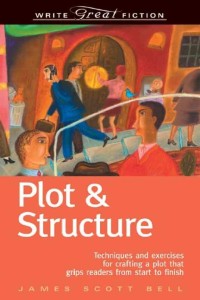 build a story that goes somewhere, and that is paced in a way that holds the reader’s attention throughout.
build a story that goes somewhere, and that is paced in a way that holds the reader’s attention throughout.
Bell’s book is all about building beginnings, middles, and endings that keep a reader glued to his chair and turning pages. It presents lots of tips and information about plot patterns, complexity, character arcs, and much more.
Let me recommend two other great books on plotting and structure by James Scott Bell–more recent titles of his that I’ve found to be exceptionally valuable.
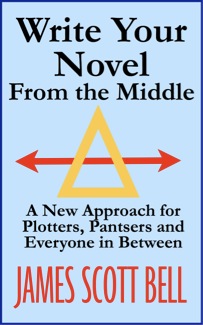
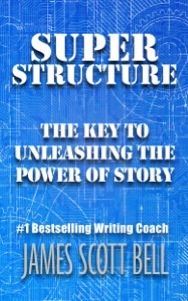
Write Your Novel From the Middle is a fresh approach to developing a plot structure for your story. It is based on an insight Bell had about a key, central point at the heart of every great story, what he calls the lead character’s “Mirror Moment”–and how to build your plot around that. I found this extremely useful in crafting my third novel.
Another recent book by Bell is Super Structure: The Key to Unleashing the Power of Story. It discusses 14 pivotal scenes or sequences in the plot of a good novel. Developing these in the proper order can help you create and pace a real page-turner.
Writing the Blockbuster Novel by Al Zuckerman–famous literary agent and editor for mega-selling authors like Ken Follett–has a narrower focus than some. His goal is to show the common elements shared by most fiction bestsellers, and explain how to work them into your stories. One of the most valuable (and encouraging) features of the book is how he shows the many evolutions of one of Follett’s most successful novels, The Man from St. Petersburg. He shows, in sequence, each draft outline of the book as Follett planned it–demonstrating in the process what every veteran writer knows: First drafts are a mess, even for bestselling authors. Successful novels are almost always painstakingly developed and polished, not dashed off. If you have commercial aspirations for your fiction, I think you’ll get a lot out of Zuckerman’s book.
Let me also heartily endorse Self-Editing for Fiction Writers by Renni Browne and Dave King. Good editing is critical for shaping a rough draft into a great reading experience. But in the self-publishing era, authors must find affordable ways to edit their fiction, because hiring a contract editor could cost a lot of money. This book is a do-it-yourself guide that takes you through a methodical process of editing, honing, 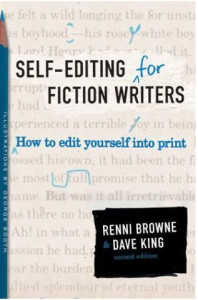 and polishing your prose. It is an outstanding book, worth every penny because ultimately it will earn you many dollars.
and polishing your prose. It is an outstanding book, worth every penny because ultimately it will earn you many dollars.
Finally, let me recommend my favorite creative-writing software package, WriteItNow (abbreviated “WIN”). Any number of useful creative-writing programs will help you organize and get your story down on paper. But for the impressive host of comprehensive features and benefits it offers writers, I think “WriteItNow” may well be the best value on the market.
The biggest benefit from creative-writing software is organizational:helping an author keep track of piles of random ideas and scattered notes about characters, themes, bits of dialogue, plot events, descriptions, and research. Here, “WriteItNow” excels and offers an array of easy-to-master tools for structuring and organizing your novel. These include both a “tree” structure of chapters and scenes; a “storyboard” of graphic “notecards” for organizing and moving them around; separate sections and aids to develop your characters and events; places to store notes and ideas on the fly; plus…
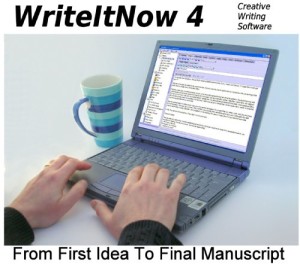 * an ingenious story timeline, automatically generated from your plot events, which flags logical inconsistencies
* an ingenious story timeline, automatically generated from your plot events, which flags logical inconsistencies
* charts and “Mind Maps” that help you graphically visualize character relationships
* a host of creativity generators, which can help you get past “writer’s block” to produce fresh ideas, character names (from a vast database), and even character personality types (based on three different “archetype” systems, including Myers-Briggs and Joseph Campbell); and
*a database of historical period details–useful for anyone writing historical or period fiction. “WriteItNow” incorporates a database of hundreds of details about major events in society, culture, and politics, classified by historical periods. You can instantly access and drop these details into your story to add authentic background and color to your tale.
The link above is to the CD version, available from Amazon. However, you can download the program directly from the website of the publisher, Ravenshead Services, for $10.00 less. You can obtain it in “demo” mode for free, so that you can try it out and see if it is for you. However, you will not be able to save or print your work until you pay for the program, at which point you’ll be emailed the access codes that will make it fully functional.
Let me conclude by saying that for hundreds of years, vast numbers of great books have been written by many thousands of authors, toiling away with nothing more than quill pens, pencils, and pens, scrawling on parchment and paper. They did so without the aid of writing courses or how-to instruction manuals, sans computers or word processors, and absent any fiction-writing software. Nor can any of these innovations substitute for your own talent, hard work, and constant practice in the art of writing.
But those who do possess talent and commitment may find value in these recommendations. They are the aids that have been most useful to me, and I hope you’ll find them useful, too.


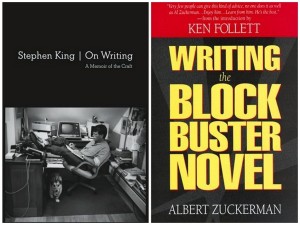
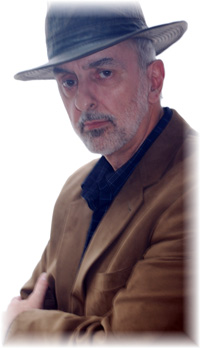 Photo (c) by Debbie Scott
Photo (c) by Debbie Scott
